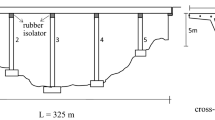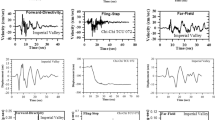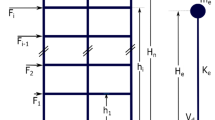Abstract
A Displacement-Based Design (DBD) procedure for bridges equipped with different seismic Isolation Systems (IS’s) is proposed. It has been derived from the Direct DBD method recently developed by Priestley and co-workers. The key aspect of the proposed procedure is the definition of a uniform target displacement of the deck, which is assigned by the designer to accomplish a given performance level, expressed through limit values of the maximum IS displacement and of the pier drift, respectively. The proposed design procedure has been developed for four different idealized force-displacement cyclic behaviours of IS’s, which can be used to describe the response of a wide variety of IS’s, including: (i) Lead-Rubber Bearings (LRB), (ii) High-Damping Rubber Bearings (HDRB), (iii) Friction Pendulum Bearings (FPB), (iv) Combinations of either Low-Damping Rubber Bearings (LDRB) or FPB and Viscous Dampers (VD), (v) Combinations of lubricated Flat Sliding Bearings (FSB) and LDRB, (vi) Combinations of FSB and Steel Yielding Devices (SYD), (vii) Combinations of FSB, Shape Memory Alloy (SMA)-based Re-centring Devices and VD. In the paper, the background and implementation of the design procedure is presented first, then some validation studies through nonlinear time-history analyses on different configurations of continuous deck and multi-span simply supported deck bridges are illustrated.
Similar content being viewed by others
References
Al-Hussaini TM, Zayas VA, Constantinou MC (1994) Seismic isolation of a multi-story frame structure using spherical sliding isolation systems, Technical Report No. NCEER-94-0007, National Center for Earthquake Engineering Research, Buffalo, NY
Bertero RD and Bertero VV (2002). Performance-based seismic engineering: the need for a reliable conceptual comprehensive approach. Earthquake Eng Struct Dyn 31(3): 627–652
Calvi GM and Pavese A (1997). Conceptual design of isolation systems for bridge structures. J Earthquake Eng 1(1): 193–218
Casarotti C and Pinho R (2007). An adaptive capacity spectrum method for assessment of bridges subjected to earthquake action. Bull Earthquake Eng 5(3): 377–390
CEN ENV-1-1 European Committee for Standardisation (1998) Eurocode 8: design provisions for earthquake resistance of structures, Part 1.1: General rules, seismic actions and rules for buildings
Chopra AK (1997) Dynamics of structures: theory and application to earthquake engineering. Prentice-Hall Ltd
Computers and Structures Inc (2002) SAP2000 Analysis Ref. Manual, Version 8.0, Berkeley, CA
Constantinou MC, Symans MD, Tsopelas P, Taylor DP (1993) Fluid viscous dampers in applications of seismic energy dissipation and seismic isolation. In: Proceedings of ATC-17-1 seminar on seismic isolation, passive energy dissipation, and active control; San Francisco, CA, pp 581–591
Derham CJ, Kelly JM and Thomas AG (1985). Nonlinear natural rubber bearings for seismic isolation. Nuc Eng Design 84(3): 417–428
Dolce M, Cardone D and Marnetto R (2000). Implementation and testing of passive control devices based on shape memory alloys. Earth Eng Struct Dyn 29: 945–958
Dolce M, Cardone D and Croatto F (2005). Frictional behaviour of steel-PTFE interfaces for seismic isolation. Bull Earthquake Eng 3(1): 75–99
Dolce M, Cardone D and Ponzo FC (2007). Shaking-table tests on reinforced concrete frames with different isolation systems. Earthquake Eng Struct Dyn 36(5): 573–596
Eggert H and Kauschke W (2002). Structural bearings. Ernst & Sohn, Berlin
Higashino M, Okamoto S (2006) Response control and seismic isolation of buildings. Taylor & Francis Ltd
Kelly TE (1992) Skellerup industries lead rubber isolation bearings: experimental properties. Holmes Consulting Group
Kowalsky MJ (2002). A displacement-based approach for the seismic design of continuous concrete bridges. Earth Eng Struct Dyn 31: 719–747
Naeim F, Kelly JM (1999) Design of seismic isolated structures. Wiley
Pettiga D and Priestley MJN (2005). Dynamic behaviour of reinforced concrete frames designed with direct displacement-based design. J Earthquake Eng 9(SP2): 309–330
Priestley MJN (1993) Myths and fallacies in earthquakeengineering—conflicts between design and reality. Bull NZ Nat Soc Earthquake Eng 26(3):329–341 (12 ref)
Priestley MJN (2003). Myths and fallacies in earthquake engineering, Revisited. IUSS Press, Pavia (Italy)
Priestley MJN, Seible F and Calvi GM (1996). Seismic design and retrofit of bridges. Wiley, New York, USA, 686 pp
Priestley MJN, Calvi GM and Kowalsky MJ (2007). Displacement-based seismic design of structures. IUSS Press, Pavia, Italy, 720 pp
Shibata A and Sozen M (1976). Substitute structure method for seismic design in reinforced concrete. J Struct Div – ASCE 102(12): 3548–3566
Skinner RI, Robinson H, McVerry GH (1993) An introduction to seismic isolation. Wiley
SSN (1998) Presidenza del Consiglio Superiore dei LL.PP. – Servizio Tecnico Centrale, Linee guida italiane per la progettazione, esecuzione e collaudo di strutture isolate dal sisma, Roma
Sullivan TJ, Priestley MJN and Calvi GM (2005). Development of an innovative seismic design procedure for frame-wall structures. J Earthquake Eng 9: 279–307
Taylor AW, Lin AN and Martin JW (1992). Performance of elastomers in isolation bearings: a literature review. Earthquake Spectra 8(2): 279–304
Zhang R (2003) Seismic isolation and supplemental energy dissipation. In: Chen WF, Duan L (eds) Bridge engineering: seismic design. CRC Press
Author information
Authors and Affiliations
Corresponding author
Rights and permissions
About this article
Cite this article
Cardone, D., Dolce, M. & Palermo, G. Direct displacement-based design of seismically isolated bridges. Bull Earthquake Eng 7, 391–410 (2009). https://doi.org/10.1007/s10518-008-9069-2
Received:
Accepted:
Published:
Issue Date:
DOI: https://doi.org/10.1007/s10518-008-9069-2




